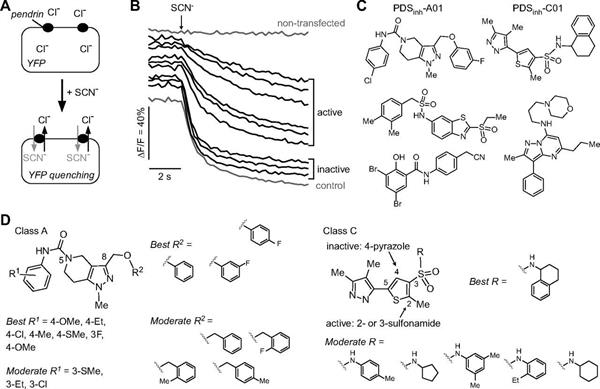Small Molecule Pendrin Inhibitors for Treatment of Inflammatory Airway Diseases and Diuretic Resistance
Invention Novelty
Small molecule pendrin inhibitors for treating inflammatory lung diseases.
Value Proposition
Cystic fibrosis (CF) is a life-limiting disease, affecting several organs including lungs, kidneys and intestine. Among the severe symptoms, lung infections are responsible for death in 80% of the patients. Most current therapies for CF rely on mucolytics or inhaled antibiotics. Medications such as ivacaftor target only a small subset of CF patients due to the well-defined genetic mutations causing CF. Therefore, a general drug therapy that could potentially alleviate symptoms in all CF patients would be very valuable.
Pendrin (PDS, SLC26A4) is a sodium-independent chloride and iodide transporter, expressed in the epithelium of inflamed airways. By alerting the airway surface liquid (ASL), a tightly regulated liquid layer that is instrumental in protecting the lung against infection, pendrin has been implicated to be the cause of the progression of inflammatory lung diseases in CF patients. Therefore, pendrin can be a therapeutic target for ASL rehydration. Currently, the best previously described compound for blocking pendrin activity, niflumic acid, produces less than 40% of inhibition and has poor potency with IC50 of 100 μM. Better molecules are needed to facilitate the development of potential therapies for human diseases.
ADVANTAGES OF THE INVENTION:
- Potent inhibitors of pendrin: IC50 of 2.5 μM
- Significantly increase ASL hydration in IL-13-treated HBE and CFBE cell cultures
- Highly-specific inhibition of pendrin compared to other ion transporters
Technology Description
Researchers in the Verkman lab at the University of California, San Francisco used a high-throughput screen of over 36,000 synthetic small molecules to identify potent inhibitors of human pendrin. Structure-activity studies were performed using primary cultured airway epithelial cells obtained from non-CF (without significant airway diseases) and CF humans. These compounds successfully achieved reversible inhibition of pendrin-mediated anion exchange with an IC50 of 2.5 μM. Treating airway epithelial cell cultures with PDSinh-A01, increased ASL depth by 8 μm, showing that pendrin inhibition enabled ASL hydration.
In 35% of the congestive heart failure patients, loop diuretic resistance occurs after taking chronic oral loop diuretics, such as furosemide. A combination treatment of furosemide and 1 μM of one of the pendrin inhibitors (PDSinh-C01), resulted in a 60% increase in urine production in a chronically-treated furosemide mouse model, suggesting that in addition of increasing ASL rehydration, these pendrin inhibitors also have the potential as therapies to enhance loop diuretic activity.

Looking for Partners
To develop and commercialize this technology as innovative therapies for patients with pulmonary, renal, and cardiovascular diseases.
Applications
- Oral, parenteral and inhalation formulations of novel diuretics, anti-hypertensives, and expectorants.
- Edema, diuretic-resistant edema, hypertension, asthma, CF, COPD, rhinitis, chronic rhinosinusitis and infection, hyperthyroidism due to thyroid nodules, hyperplasia, thyroiditis.
Stage of Development
Preclinical
Related Materials
Patent Status
| Country | Type | Number | Dated | Case |
| Germany | Issued Patent | 3419612 | 11/06/2024 | 2016-154 |
| France | Issued Patent | 3419612 | 11/06/2024 | 2016-154 |
| United Kingdom | Issued Patent | 3419612 | 11/06/2024 | 2016-154 |
| United States Of America | Issued Patent | 10,702,506 | 07/07/2020 | 2016-154 |
Contact
- Todd M. Pazdera
- todd.pazdera@ucsf.edu
- tel: View Phone Number.
Inventors
- Cil, Onur
- Haggie, Peter M.
- Verkman, Alan S.
Other Information
Keywords
Pendrin, Small Molecule, Inflammatory Airway Diseases, Diuretic Resistance, Cystic fibrosis (CF)
Additional Technologies by these Inventors
- SALT-SPARING UREA TRANSPORT INHIBITOR DIURETICS FOR TREATMENT OF CARDIOVASCULAR AND RENAL DISORDERS
- Potent TMEM16A Small Molecule Treatment for Inflammatory and Reactive Airway Diseases, Asthma, Hypertension, Pain and Cancer
- Novel Small Molecule Drug for the Treatment of Constipation and Oxalate Kidney Stones
- Immunotherapy for Treatment of Neuromyelitis Optica (NMO)
